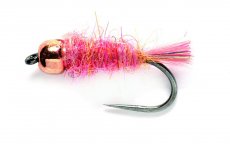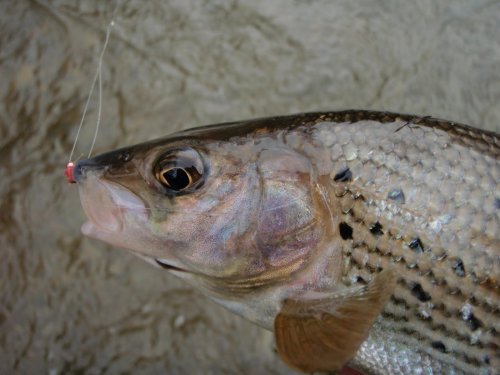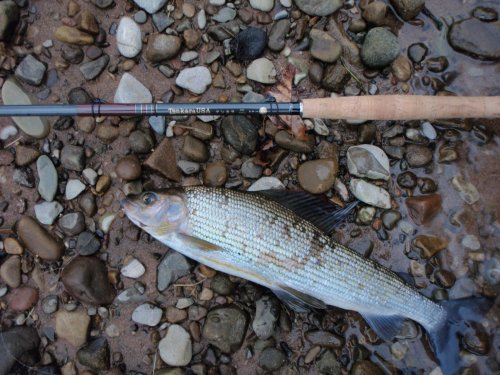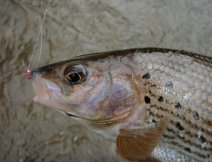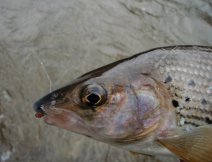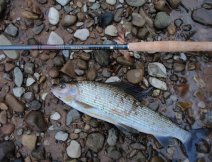Nymph fishing thoughts from Jeremy Lucas.
The single-most crucial aspect of good nymph fishing on the river is control, although most anglers are either not really aware of what is required for control, or are in denial. To be clear: control is defined as the ability to maintain a dead-drift of the nymph(s), with contact, such that any extra movement of the rod tip will bring about a movement of the nymph(s), faster than the current. Many nymph fishers intentionally accelerate the line during a drift when ‘leading’, and this is undoubtedly a successful technique for summer fish - trout and grayling - when they are actively feeding, though is seldom successful in colder water, for winter grayling for example. By default, while leading flies, the angler is necessarily in contact, but the dead-drift reigns supreme for much of the time, and it is the ability to achieve this, consistently, while maintaining contact, that really differentiates the river anglers out there.
The situation becomes even more critical with dry fly, actually, because having overmuch contact here results in the disaster of drag, and having too little contact results in a line or leader on the surface (or, worse, sunk), which is at the mercy of the disparate currents; either way the angler is out of control.
For three months, as I write this, we have not seen a single fish on the surface of the Eden. In the cold, often high, river the grayling have been feeding, but remaining deep, reluctant to move off station even a little. The dead-drift has been everything. Provided a suitable nymph can be presented at current pace, exactly where the fish are lying, takes are forthcoming, but to be off the holding areas, even by inches, or to accelerate the nymphs, and you can think you are fishing in a grayling desert. Oddly, it reminds me of the supreme accuracy required for big grayling feeding on emergers or duns on the summer river. If you miss these very precise feed lanes, or drag the fly even by an imperceptible amount, the grayling will not rise. Throughout winter, I have been fishing with either a leader-only rig on a 10’ two weight or a 12’ tenkara using a furled indicator leader. These offer remarkable similarities in terms of presentation, and in both cases I have been using exclusively double nymph rigs (separated by approximately 40cm). While delighting in the ultimate simplicity of the tenkara, the western-style has the edge and this is entirely because of the extra control by virtue of being able to gather or yield line. This allows the angler to measure each cast, keeping in contact, altogether without the extreme rod arm movements and wading positioning required by the fixed-line approach. At the optimum range, which using a 3.6m (12’) rod and fixed line/leader of about 4m, is actually somewhere in the region of 6-8m, the dead-drift presentation is exemplar, with excellent control (this, given that the nymphs are chosen very carefully in terms of their mass - see below). With the western-style approach and the use of an appropriate leader-only rig, the range extends realistically out to about 12m; but more significantly it is a comparatively simple matter to fine-tune each cast, by line gathering or extending, such that control can be consistently maintained.
It is most noticeable, however, that both approaches are tantamount to the increasingly utilised ‘Euro-style’, mostly because of the distinct presentation and control advantages that can be attained by avoiding the use of conventional fly line. The angler is not really conscious of the differences, rather the way in which he can achieve this all-important control.
I mentioned that the weight of the nymphs was also crucial - more so than the actual pattern - and more subtly, the balance between the flies on the rig. One of the nymphs (and I nearly always opt for the point) must been sufficient to be occasionally touching bottom in the depth of water drifted. I have found that this can often be a semi-sacrificial role in that this fly frequently does not catch the majority of the fish, but certainly allows the dropper fly to present properly at the right depth. The latter, then, should be much less ballasted and significantly smaller than the point fly. Four patterns have seen me through the last three winters: as follows.
The ‘Euro jig’, is a staggeringly successful pattern, largely by virtue of the way the jig style allows the hook bend and point to present inverted, which hugely reduces fouling on the river bed. This pattern is slim and sparse and sinks rapidly to the bottom in even pacey water. On a 12 or 14 jig hook a 3 - 3.5mm silver tungsten bead is threaded and locked in place with four turns of fine lead wire. An underbody of thread is built up (tapered) and varnished. Tail consists of Coq de Leon. The abdomen is stripped peacock quill (natural, yellow, orange or crimson are all effective) while the thorax is a mix of dubbed hare (or squirrel) and CDC (and Ice dub has proved very successful). Interestingly, this jig pattern was developed simultaneously, and almost identically, by at least five different European teams, to my knowledge.
My version of the pheasant tail, which is essentially a Sawyer-style pattern incorporating a 2.8mm copper or black tungsten bead and ‘legs’ consisting of four peeled pheasant tail stubs tied in at the thorax, under the wing case, has been a great pattern for either point or dropper. This variant has often been referred to as a ‘Czech-style’ PTN.
Very similar to this nymph - and simply a good ‘change’ pattern - is the hare fur bug, which consists of hare fur dubbed and tapered on a curve shank hook (go for the outstanding Tiemco 2499 SPBL, which in my view are the best hookers and holders ever designed). Again, I use a 2.4 or 2.8 copper or black tungsten bead for this pattern, and also add a pearl mylar ‘wing case’.
The tup bug has been incredible lately - see the illustrations here. A gentle pink wool (avoid fluorescence or really bright pink) is dubbed and ribbed with fine copper wire. The head is a 2.4mm copper tungsten bead. I used to add pearl mylar as a tail or wing case to this pattern, but no longer do so. I actually believe that, like fluorescence, over-flashy materials can spook fish, particularly big grayling, so I tend almost always to dispense with these, unless in coloured water.
Finally, ceramic nymphs have been an increasing feature throughout the European scene. If ceramics are not the future of high-performance nymph fishing, they are at least a very significant part of it. The French have been using these - noticeably on very heavily pressured waters, with incredible results, for a decade now. Gradually, other European anglers are catching on, and, so slowly, the British. I am sure that with nymph fishing opportunities anywhere in the world, the ceramic nymph will prove revolutionary. It all comes down to that facet of control. The ultra-slim, dense profile of these nymphs, with life-like characteristics and form, offer a new level of presentation and control. If I were competing nowadays, most of my river nymphing would be based on ceramic nymphs.








